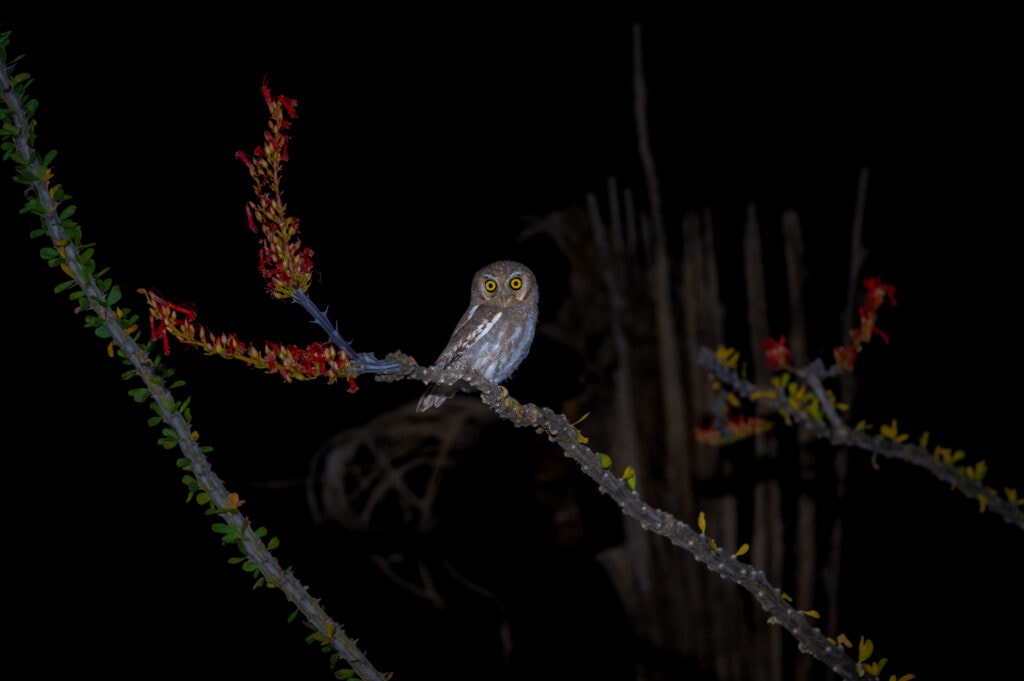Did you know that there’s an owl that’s as small as a sparrow and could easily fit in the palm of your hand? Now you do! The aptly named Elf Owl is the world’s smallest raptor alongside its phylogenetic “sister species,” the elusive Long-whiskered Owlet of the Peruvian cloud forests.
Although the Long-whiskered Owlet is of similar size, the Elf Owl is lighter, securing it the title of the itsy bitsy-est raptor around. Elf Owls are found in limited stretches of the southwestern United States, Baja California, and Mexico.
Related Article: Species Spotlight: The Harpy Eagle
Fun Facts About the Elf Owl
If being tiny isn’t interesting enough, don’t worry! There’s plenty more to learn about the Elf Owl. Let’s explore some fascinating Elf Owl fun facts.
Even smaller than you think: Have I mentioned that Elf Owls are tiny? Well they’re even smaller than you’re probably picturing. Roughly 5 inches long and with a wingspan that reaches roughly 9 inches, the Elf Owl weighs between 1 ounce and 1.5 ounces. This is roughly the weight of a single pencil. The Elf Owl’s weight is about 32 times lighter than that of the Great Gray Owl — North America’s largest owl — and its wingspan is barely more than a fifth of Great Gray’s impressive four foot wings.
Tiny but mighty: Though small, the Elf Owl can be surprisingly fierce. Despite typically being territorial toward fellow Elf Owls, these tiny raptors have been observed banding together to “mob” predators who come too close. Mobbing is a common bird behavior wherein small birds will gang up on predators to drive them away. Despite the risks to life and limb, Elf Owls may even swoop and strike enemies, relying on the safety of teamwork to protect them.
Peculiar pest control: Elf Owls typically eat insects and arthropods like moths, scorpions, and beetles. In some cases, though, they hunt tiny snakes called threadsnakes. Oddly, they do not catch these snakes to eat. Instead, they bring threadsnakes home to the nest alive. There, the snakes consume the parasites that threaten the health of the nest. It’s a clever and unexpected for of pest control that helps keep hatchlings safe and healthy.
Cactus sweet cactus: Speaking of nests, the Elf Owl’s nest choice is itself often helps keep these birds safe from predators. Elf Owls are cavity nesters and often nest in holes left behind by woodpeckers. They nest high up in trees where they are hard to reach and, quite often, their preferred nesting sites are Giant Saguaro Cacti. The tall and prickly Saguaro Cactus offers an extra layer of protection and Elf Owls often thrive in regions of the Southwest where these cacti are plentiful.
Playing possum: When threatened, most Elf Owls will do whatever they can to flee the danger and hide themselves. If the worst comes to pass and the Elf Owl is captured, they will “play dead” until the predator moves on.
The Future of the Elf Owl
Elf Owls are considered to be of “Least Concern” by the IUCN’s Red List of Threatened Species. Despite this, the IUCN notes that Elf Owl populations are in decline. Elf Owls are heavily reliant on specific environmental factors. In riparian scrublands, the health and integrity of the waterways is essential. In the Southwestern desert, the presence of Giant Saguaro Cacti is a significant factor. The Elf Owl’s decline should be taken as a warning that these habitats are degrading and must be preserved before the relative stability that this species enjoys is lost.
Popular Article: Species Spotlight: The Bobolink

